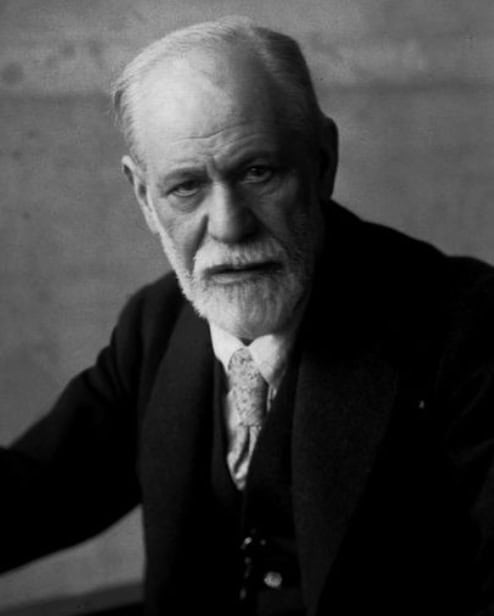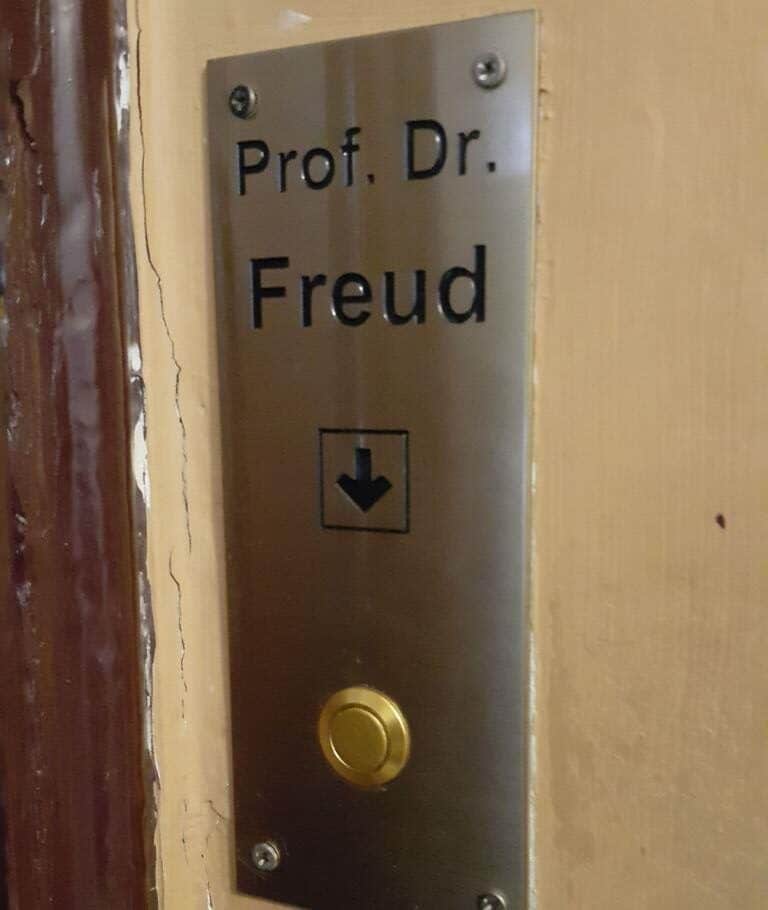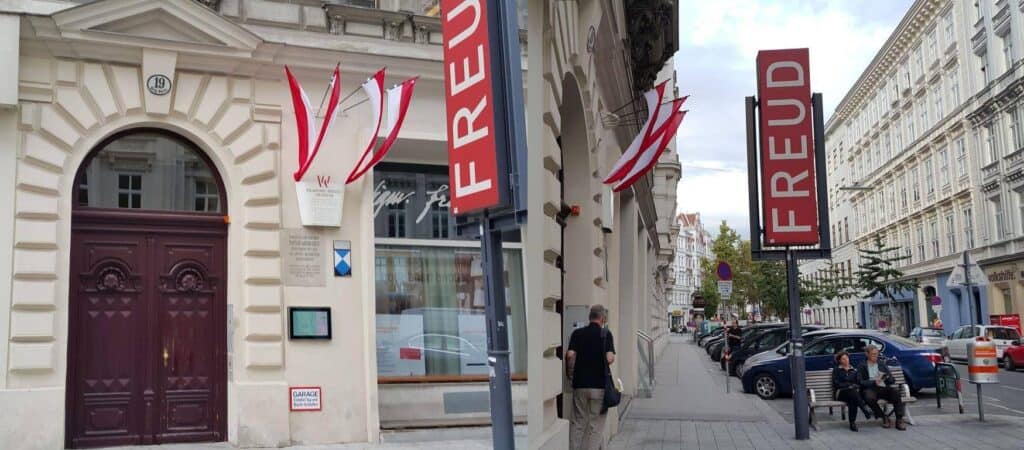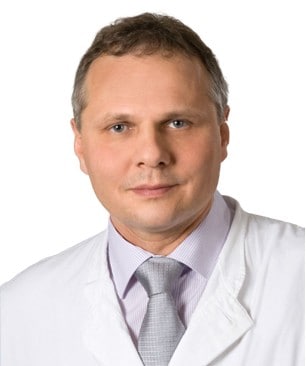
Freud’s Biography. Introduction
Man, and his ideas can be only understood in the context of his life and the time period when he lived. This short biography of Freud introduces the reader into the period between the late 19th and beginning of the 20th century and expands on the development of psychoanalysis.
Sigmund Freud was an Austrian neurologist who graduated from the University of Vienna, Austria. He conducted his research at the university, later was appointed to lecturer, and in 1905 became a professor at the University of Vienna.
Freud’s epchal achievement was the developement of psychoanalysis and its applcation as the first effective method of psychotherapy.
The end of the 19th century was the time of revolutionary ideas in arts, science and politics. This tumultuous socio-political movements changed the old-world order and found its climax in the horrors of World War I.
Sigmund Freud. Family Background
Sigmund Freud was born in 1856 in Freiberg (now Pribor, in the Czech Republic), a small town in the former Austro-Hungarian Empire. He was the first of eight children. His parents Jacob Freud and his mother, born Amalia Nathanson, 20 years junior to her husband, were of Jewish origin. His father Jacob was a wool merchant. Struggling with financial difficulties the family left Freiberg in 1859, first for Leipzig in the German Empire, and then for Vienna, the capital of the Austro-Hungarian Empire.
Since Freud was Jewish, Sigmund’s early experiences were largely those of an outsider in the Catholic community. The Emperor Franz Joseph (1830–1916) emancipated the Austrian Jews, liberated them from ghettos, gave them the same rights as the other citizens, and opened new opportunities for the Jewish population. In this time many Jewish families moved from the other parts of the Empire, especially from the rural areas in Galicia (today’s part of Ukraine and South Poland) settling in Vienna and hoping for better life. The Freud family settled in Leopoldstadt, a district of Vienna, which had a high percentage of Jewish inhabitants. At the beginning the family lived in cheap accomodations.
Freud’s School Years
After the age of 9, Freud joined the local primary school. From 1866 he continued his education at Sperl-Gymnasium in Leopoldstadt (in Europe gymnasiums prepare for university entrance), which at that time was one of the best schools of Vienna.
The higher education in Europe at the end of the 19th century was influenced by the culture of antiquity. Apart from mathematics, history, and the natural sciences, the students learned Greek, Latin and the history of the antiquity. The influence of this classic education will find its echo in Freud’s psychoanalytical theory in terms based on Greek mythology, such as the Oedipus complex.
Freud was an excellent student. He passed his final exams with distinctions. His family was aware of his special scientific genius from an early age, allowing him to have a room to himself, while his siblings shared theirs. Sigmund was undoubtfully his mother’s favourite child who called him “mein goldener Sigi”, “my golden Sigi”. When Sigmund studied his sister Anna was not allowed to play piano.
Freud lived with his parents until the age of 27 as was the custom at that time.
University of Vienna. Studies and Career

In 1873, at age 17, Freud was admitted to the medical faculty at the University of Vienna. He finished the university as Doctor of Medicine not until 1881. Because of his broad interests, it took him nine years to get his degree in medicine. He participated in neurophysiological research under Ernst Brücke, visited lectures in philosophy under Franz Brentano and in zoology under Carl Claus, a strong supporter of Darwinism.
After finishing the university Freud continued the research at the Vienna University in the field of neuropathology in the laboratory of Ernst Brücke. His research was dedicated to studies on nervous tissue of vertebrates. In 1885, he completed his research acquiring habilitation in neurology.
Marriage
In 1886 Freud finally opened his own practice in Vienna and soon afterwards married Martha Bernays, the daughter of a respected Jewish family from Hamburg, Germany. A total of six children, three sons and three daughters, were born of this marriage. In 1891 Freud moved his practice to Berggasse 19. He lived and worked at this address until his departure for exile in London
Freud’s Jorney from Neurology to Psychoanalysis
Beginning in 1881 Freud joined the Vienna General Hospital as a physician where he worked in different departments. In parallel, he conducted studies in the field of neurology. His research created one of the cornerstones for the discovery of neurons. He published papers on aphasia. His other interest was the psychopharmacology. In 1884, Freud publisheda paper “On Coca,” from tuday’s standpoint a controversial study. However in this time cocaine was a newly extracted drug with stimulating properties. Freud assumed that it can be used for the treatment for alcohol and morphine addiction. After having discovrered the addictive nature of cocaine he abandoned the studies.
In 1885 he got a grant from the Austrian government which allowed him to travel to Paris and to participate in the lectures of Jean Martin Charcot in the Salpêtrière hospital in Paris. Salpêtrière, at that time, was the leading hospital in the field of neurosciences. He stayed in Paris from October 1885 to February 1886.
Salpêtrière
At that time Charcot was one of the most famous physicians in Europe. Charcot was trained as neurologist but dedicated his attention to hypnosis. Freud witnessed Charcot inducing pseudo-epileptic, so-called hysterical seizures, in patients through hypnosis. This strengthened Freud in his assumption that the triggers of certain diseases are not of a physical, but of psychological origin.
The term “hysteria” derives from the Greek word “hystera”, which means “womb”. In the 19th century hysteria, which means an “over-excited behaviour,” was exclusively diagnosed in women. By demonstrating that traumatic experiences can lead to hysteria in everyone, Charcot contradicted this hypothesis for the first time.
Hysteria and sexuality
Freuds patients, mostly women, belonged to the Viennese upper-class. This part of the society adhered to to the rigid morality of the 19th century, called the “Victorian era“. The reason that the symptoms of hysteria appeared especially in young girls and women was the conservative nature of the society which prohibited any expression of erotic desires, especially in higher class women. This led to internal conflicts between societal values and desires. Such inner tension was the triggering factor for the onset of neurosis in a big percentage of upper-class females.
Freud, who was neurologist and possessed little knowledge in the field of psychiatry. His psychiatric experience was limited to few weeks of training in one of the psychiatric hospitals in Vienna. Based on the observation of his upper-class female clients, Freud generalized and put sexuality as the corner stone of the neurotic conflict and sexuality as the only origin of neurosis..
Work with Josef Breuer
After Ernst Brücke, the second most important figure in Freud’s biography became Josef Breuer. Freud initially treated the “nervous ailments” of his patients with hypnosis. From 1889 he worked more closely with his long-time friend, the Viennese doctor Josef Breuer. Together they investigated the case of Bertha Pappelheim, who later became known under the pseudonym Anna O. From 1880 to 1881 Breuer treated her “hysterical” symptoms, which were headaches, paralysis, dissociation and states of anxiety. Breuer quickly recognized psychological causes behind these signs and soon developed the so-called “talking cure”. Actually, it was the young girl who in the hypnotic state called the therapy the ”talking cure”. At the same time, Bertha P. reported on her symptoms, when and how they had occurred and was thus able to slowly break down the pent-up feelings she had relived again.
From this Freud and Breuer concluded on the one hand that talking has a cathartic, i.e. cleansing effect, since it can influence the processes of the unconscious. They also came to the conclusion that the cleansing process must be free and only based on the patient’s thoughts to have an effect. Thus, Josef Breuer had taken the first step in the development of psychoanalysis.
Friendship with Wilhelm Fliess
After Josef Breuer, the ENT doctor Wilhelm Fliess became an important interlocutor for Freud. Their regular correspondence developed into a written “speech cure.”
In the years 1885-1900 Freud started self-analysis. Actually, it was Carl Gustav Jung who emphasized the necessity of the analysis as a part of the training for the future therapists. Today analysis became a part of the psychotherapeutic training curriculum.

The Interpretation of Dreams
In his letters to Fliess Freud reported, among other things, about his dreams and fantasies. By now he was aware that dreams are much more than incoherent visual fantasies appearing during sleep. Much more they opened up to him as a way into the deeper layer of the psyche. He wrote: “The dream is the royal way to our soul”.
On 1900 Freud published “The Interpretation of Dreams”, which he considered to be one of the most important works of his life. To justify and explain his theories, he went into the stories of his anonymous patients as well his own dreams.
Developement of Psychoanalysis
After giving up on hypnosis, Freud developed psychoanalysis based on his own method of interaction with patients he called “free association”. During free association patients spontaneously expressed their thoughts, feelings and talked about their dreams. Later he analysed the patients’ “material” from their free association and their dreams. Freud discovered such psychological phenomena as repression, transference, countertransference, and psychological defence mechanisms.
Ego, Id and Super-Ego
He constructed a theoretical model representing the human psyche. Freud’s psychic structure had different entities, including Id, Ego, and Super-ego. He created the psychological term “libido,” the source of psychic energy, which in his view was of purely sexual origin. He postulated the existence of infantile sexuality and formulated the concept of the Oedipus complex. In his later works, Freud analysed different aspects of society such as culture, religion and war. He became one of the most important thinkers of the 20th century. Freud’s ideas redefined Western thought and have been absorbed within popular culture and language. Despite its declining prominence, Freudian-style psychoanalysis is still in use in a wide variety of ways. However, it was psychoanalysis that created the foundation for all contemporary methods of psychodynamic psychotherapy.
Reaching the psychiatric community
The publication of “The Interpretation of Dreams” aroused the interest of many doctors and educators far beyond the borders of Austria. Many students and fellow campaigners soon gathered around him, including psychiatrists from the most famous psychiatric hospital Bürgholzli in Zürich, Switzerland, among them Eugen Bleuler, the medical director of the hospital and Carl Gustav Jung, the chief of staff at the same hospital. Carl Gustav Jung became the closest collaborator of Freud over a period of 7 years. In 1905 Freud, Jung and Sandor Ferenczi travelled to a congress at the Clark University in the USA. This visit initiated the spread of psychoanalysis in the USA.

International Psychoanalytic Association

The involvement of several reputable psychiatrists from Zürich Burghölzli Psychiatric Hospital, became a turning point in Freud’s biography and in the development of psychoanalysis. The active participation of Eugen Bleuler and Carl Gustav Jung in the psychoanalytical movement helped the psychoanalysis to move out from the restricted circle of Viennese psychoanalysts, all of them of Jewish origin und under heavily attacks by conservative scientists. The final consolidation of the movement happened trough the creation of the “International Psychoanalytic Association“. The International Psychoanalytic Association was founded in 1910 with Jung as its first president. Winning such reputable figures as Bleuler and Jung facilitated the spread of the psychoanalytical theory.
Authoritarian leader
Freud despite his indisputable genius was a difficult person. Over time he repeatedly changed or expanded his psychoanalytic theory. However, he didn’t tolerate any deviation from his own theory by others. He treated those who modified his ideas as traitors. Over years his close collaborators and friends such as Alfred Adler, Carl Gustav Jung, Wilhelm Stekel, Herbert Silberer, left him.
Freud’s most friendly and professionally close disciples, the German psychiatrist and psychoanalyst, Karl Abraham and Ernest Jones, also psychiatrist and psychoanalyst from the UK, remained loyal to him for life, unlike many of his other followers. Abraham founded the “Berlin Psychoanalytic Institute,” which became one of the most important psychoanalytic centers in the German Empire. Ernest Jones helped the spread of Freud’s ideas in Canada and the US. He left Britain for Canada in 1908 and was lecturing in the Department of Psychiatry of the University of Toronto. In 1910 he initiated the foundation of the American Psychopathological Association and in 1911 the American Psychoanalytic Association.
Psychoanalysis and Philosophy
Even as a student, Freud excelled with his ability to formulate, which was particularly useful in his later works. His reading Shakespeare, Goethe, and Schopenhauer influenced Freud’s work. At the age of seventeen, he read Nietzsche, the German philosopher, whose ideas might have inspired him in the development of his psychoanalytical model of human psyche.
During his internship in Paris, he was strongly influenced by Martin Charcot. The first and the most important case in the history of psychoanalysis, Berta Pappenheim (Anna O.) was not Freud’s patient. It was Josef Breuer who treated the young girl and reported to Freud about the treatment. Freud didn’t discover the “unconscious.” Psychologists and psychiatrists were aware of a deeper layer of psyche before Freud. However, Freud developed the first usable method of psychotherapy, a theory of the organization of the human psyche and created the psychoanalytical terms used until today.
Last chapter


When the Nazi Germany invaded Austria in 1938, Freud supported by his former patients left Vienna for London. It is in London where he stayed for the remainder of his life. He passed away at age 83.
Freud began smoking cigars at age 24. He was reluctant to abandon this habit despite warnings from his friend Wilhelm Fliess, an ENT doctor. Freud used to smoke 20-cigars per day. Finally, in 1923 he was diagnosed with palate cancer and went through 34 surgical procedures. His cancer continued spreading and his life quality became unbearable. Freud died in 1939 in London through euthanasia.
After Freud left Vienna all his furniture and belongings were shifted to London. The legendary couch is now publicly exhibited in the Freud Museum in London. Freud had lived in Vienna nearly his entire life. He had practiced psychoanalysis for 50 years under the address Berggasse 19. Freud’s practice in Vienna was also turned into a museum. However, the rooms are empty, showing only the photographs of the former interior.


DR. GREGOR KOWAL
Senior Consultant in Psychiatry,
Psychotherapy And Family Medicine
(German Board)
Call +971 4 457 4240
